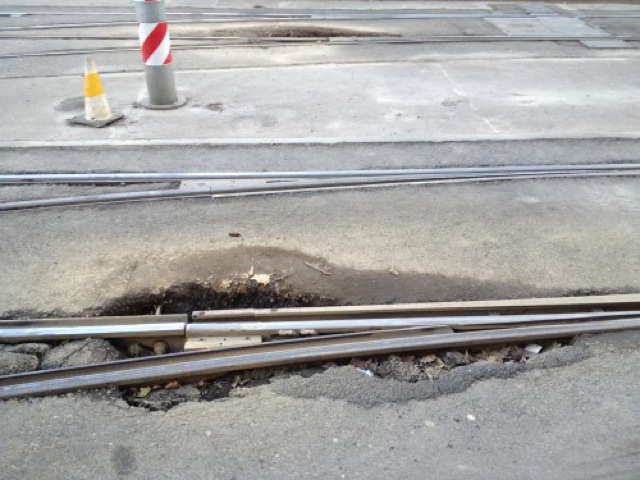Portland Transit Implodes

Worn pavement and light-rail switch near Portland’s Lloyd Center. Photo from Max FAQs.
The Antiplanner has repeatedly harped on the fact that rail transit infrastructure basically lasts only 30 years and then must be replaced, often at greater expense (even after adjusting for inflation) than the original construction cost. Part of the cost is dealing with the interruptions in service that are almost inevitable when replacing rails, wires, and other fixed hardware.
Portland’s first light-rail line is only 28 years old, but it is already wearing out. Moreover, the most worn-out part happens to be a segment that all of Portland’s light-rail lines use. Shutting down this segment means shutting down the entire system.
TriMet, Portland’s transit agency, planned to have shuttle buses move passengers around the work, but the plan apparently didn’t work very well. To make matters worse, Portland temperatures rose above 90 degrees, leading TriMet to issue slow orders for all of its trains to avoid damage to wires or derailments due to kinks in the tracks. Funny; buses don’t have to slow down when the mercury rises.
TriMet claims that hardships created by the recent recession forced it to fall behind schedule in its trackwork. But this is just one more reason why transit agencies shouldn’t build rail lines: recessions can’t be predicted, and rails are a lot more sensitive to deferred maintenance than buses.
Speaking of buses, someone asked me for my response to APTA’s Art Guzzetti, who claimed a couple of months ago that my comparison of bus and rail was “fatally flawed” because my “methodology in determining capacity of buses vs. light-rail doesn’t include ‘dwell time,’ which is time riders spend paying fares, going up or down bus steps and so on.” I don’t know why he would think I failed to account for that.
Real-world observations of buses in San Antonio found that a single bus stop can handle 42 buses an hour. Portland uses a “skip stop” system in which there are four bus stops in every two blocks and all bus routes are assigned to one of the four stops. Using this system, Portland was able to schedule 160 buses per hour down a city street, only slightly below the capacity of 168 per hour if each stop can handle 42 per hour. All this is documented in a PowerPoint show on bus capacities by Portland State University professor Robert Bertini.
Moreover, my recent paper on rapid buses proposes that people pay to enter the bus stops (as they are supposed to do to enter light-rail stops), allowing them to quickly board buses without delays caused by fumbling for exact change. While this paper came out after Guzzetti made his comments, as a former transit agency executive, he should know that there is no reason why the subway turnstile system or light-rail’s honor system couldn’t be applied to buses with limited stops. Curitiba, Brazil, for example, uses a turnstile system with elevated bus platforms, allowing rapid entry to and exit from buses that should make it possible for a single bus stop to serve even more than 42 buses per hour.

No comments:
Post a Comment